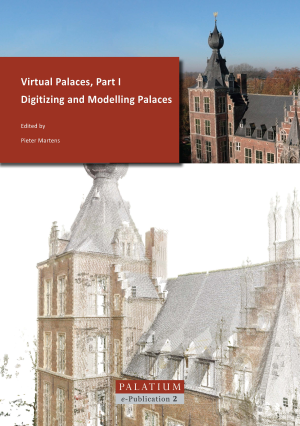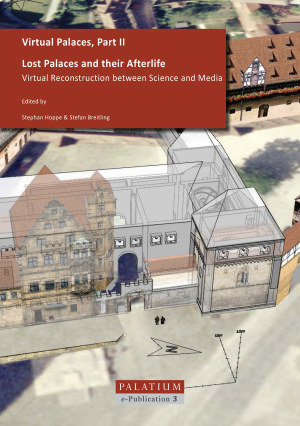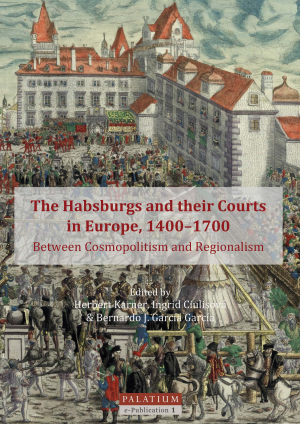De Jonge, Krista
Virtual Palaces, Part I: Digitizing and Modelling Palaces
This volume explores the potential role of virtual models for scientific research on historic palaces. The rise of digital surveying and modelling techniques has revolutionized the ways in which historic buildings such as court residences can be studied. These new techniques offer unprecedented opportunities for architectural historians but also lead to new challenges.
One challenge is the reliability and verifiability of the data that is used to make digital models, whether surveys of extant buildings or reconstructions of lost buildings. Another is the use of virtual palaces as research instruments in their own right – not just to communicate results to the wider public, but as genuine research tools that help visualize and clarify hypotheses about issues such as construction phases or the spaces’ ceremonial use.
The Interior as an Embodiment of Power: The Image of the Princely Patron and its Spatial Setting (1400-1700)
This volume is dedicated to the study of the in- and outside of princely residences and of their setup as the stage for a developing European early modern court culture. At a time of increasing aristocratization (1400-1700) and with many new nascent princely courts, both the princely person and the performance of princely power required an appropriate type of elaborate backdrop as its setting. Even though such an interest in the palace interior and its functions is not entirely new, interior architecture and court culture have only recently come to be seen as two sides of the same medal: embodiment and expression of the princely presence.
Therefore, the essays included focus in particular on diverse types of functions that palaces and apartments, state rooms and privy chambers had to fulfil at certain periods and in certain residential contexts between the ages of feudalism and absolutism at courts in London, Edinburgh, Neuburg am Inn, Karlstein and Prague, Červený Kameň and Ludwigsburg. They compare and contrast specific local examples with international trends such as, for example, the palace and court ceremonial developed at or adapted to diverse circumstances in Burgundy, Spain or Lithuania. Consequently, the aim of this volume consists of the combination of personal and dynastic ambitions with fashionable trends and court etiquette followed by royalty and minor princes alike during a period of calculated magnificence. It considers processional routes towards the presence of the ruler or towards its image. Thereby, it helps to define the complementary roles of residential interiors and of the courtly personnel at the same time.
The ten papers collected in this volume were first presented at the PALATIUM colloquium The Interior as an Embodiment of Power―The Image of the Prince and its Spatial Setting (1400–1700), organized by Stephan Hoppe, Krista De Jonge and Stefan Breitling and held in Bamberg in October 2013.
Virtual Palaces, Part II: Lost Palaces and their Afterlife. Virtual Reconstruction between Science and Media
This volume deals with digital reconstructions and visualizations of palaces, castles, and other kinds of residential architecture of the early modern period. It focuses not so much on the digital modelling of extant buildings, but rather on the virtual reconstruction of ‘lost’ buildings – in particular of palaces destroyed or drastically altered, or which were never actually built in the first place.
The thirteen papers collected in this volume were first presented at the PALATIUM workshop Virtual Palaces, Part II held in Munich in April 2012.
Looking for Leisure: Court Residences and their Satellites 1400–1700
This volume focuses on the leisure buildings – often called casino, palazotto or Lusthaus – which formed an integral part of princely residential complexes in Europe in the period 1400–1700. The aim of this collection is to study these satellite buildings as counterparts to the main palaces. The relatively small size of these structures belies their importance. They took on representative roles and developed certain ideological programmes that would have been difficult to achieve in the larger residential buildings.
Many of these buildings were meant only for seasonal use. Their primary role was as a place of rest, leisure and repose. This relaxation could either take a contemplative form or could include such vigorous activities as hunting, sports and various court festivities. The case studies presented here illustrate the shared principles of these recreational buildings and investigate how their architects and patrons attempted to realize a ‘paradise on earth’ and managed to bring the human world into harmony with the natural world.
Discussing examples from all over Europe – from Central Europe via Italy and France to Denmark and Scotland – the seventeen papers gathered in this volume address four different aspects of ‘palazotto culture’: the terminology that was used to identify these small palaces, which reflects the wide variety of needs they fulfilled; the functions and typologies of these buildings; their artistic decorations; and their gardens and natural surroundings.
The Habsburgs and their Courts in Europe, 1400–1700: Between Cosmopolitism and Regionalism
This volume examines the architecture and culture at the various courts of one of Europe’s most important royal dynasties, the Habsburgs. It looks for a specific Habsburg idiom in the sphere of princely representation at the courts in Madrid, Brussels, Vienna, Prague, Bratislava and Budapest, and contrasts the supranational features of this dynastic identity to its regional incarnations.
The nucleus of princely representation was the court residence. Hence the Habsburgs’ official apartments are studied in relation to their court ceremony, to see if a unifying model was adopted in the different palaces in Brussels, Madrid and Central Europe. The supranational dynastic identity developed by the Habsburgs is then compared with local forms of identity, as articulated by the nobility in Bohemia, Hungary and Poland. This shows how the palaces and their decoration also expressed loyalty to the traditions of the homeland, so-called Landespatriotismus.











